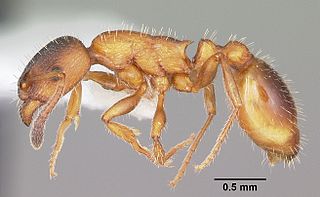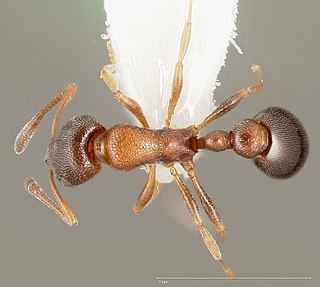
Ants are eusocial insects of the family Formicidae and, along with the related wasps and bees, belong to the order Hymenoptera. Ants evolved from vespoid wasp ancestors in the Cretaceous period. More than 13,800 of an estimated total of 22,000 species have been classified. They are easily identified by their geniculate (elbowed) antennae and the distinctive node-like structure that forms their slender waists.
Cardiocondyla zoserka is a species of ant in the genus Cardiocondyla. It is native to Nigeria.

Cardiocondyla is an Old World genus of ants in the subfamily Myrmicinae.

Leptothorax is a genus of small ants with mainly Holarctic distributions. The genus is notable for its widespread social parasitism, i.e. they are dependent on the help of workers from other ant species during a part or the whole of their life cycles.

Crematogastrini is a tribe of myrmicine ants with 64 genera and 8 fossil genera.

Romblonella is a genus of myrmicine ants.

Stereomyrmex is a genus of myrmicine ants. Two of the described species are known from only a single worker, making this one of the rarest groups of ants in the world.
Cardiocondyla elegans is an ant species in the genus Cardiocondyla found in the Mediterranean region.
C. carbonaria may refer to:

Cardiocondyla pirata, or pirate ant, is a species of ant in the subfamily Myrmicinae. Known from the Philippines, the female castes show a pigmentation pattern not known from any ant worldwide. Little is known about their biology.
Aphaenogaster avita is an extinct species of ant in the subfamily Myrmicinae known from a solitary early to middle Miocene fossil found in Japan. At the time of description A. praerelicta was one of twelve Aphaenogaster species to have been described from fossils and the only fossil species from Japan.

An ergatoid is a permanently wingless reproductive adult ant or termite. The similar but somewhat ambiguous term ergatogyne refers to any intermediate form between workers and standard gynes. Ergatoid queens are distinct from other ergatogyne individuals in that they are morphologically consistent within a species and are always capable of mating, whereas inter caste individuals, another class of ergatogynes, often are not. Ergatoids can exhibit wide morphological differences between species, sometimes appearing almost identical to normal workers and other times being quite distinct from both workers and standard queens. In addition to morphological features, ergatoids among different species can exhibit a wide range of behaviors, with some ergatoids acting only as reproductives and others actively foraging. Ergatoid queens have developed among a large number of ant species, and their presence within colonies can often provide clues on the social structures of colonies and as to how new colonies are founded. Without wings, almost all species of ants that solely produce ergatoid queens establish new colonies by fission.

Cardiocondyla emeryi is a species of ant in the subfamily Myrmicinae. There are two subspecies recognized. The type subspecies is found in numerous countries, through its large introduced range.

Cardiocondyla nuda is a species of ant in the subfamily Myrmicinae. It is a widespread ant species, and not invasive in nature.

Cardiocondyla mauritanica is a species of ant in the family Formicidae.
In ecology, a tramp species is an organism that has been spread globally by human activities. The term was coined by William Morton Wheeler in the bulletin of the American Museum of Natural History in 1906, used to describe ants that “have made their way as well known tramps or stow-aways [sic] to many islands". The term has since widened to include non-ant organisms, but remains most popular in myrmecology. Tramp species have been noted in multiple phyla spanning both animal and plant kingdoms, including but not limited to arthropods, mollusca, bryophytes, and pteridophytes. The term "tramp species" was popularized and given a more set definition by Luc Passera in his chapter of David F William's 1994 book Exotic Ants: Biology, Impact, And Control Of Introduced Species.











